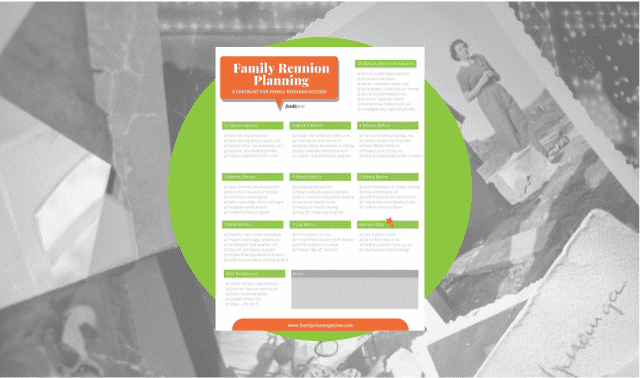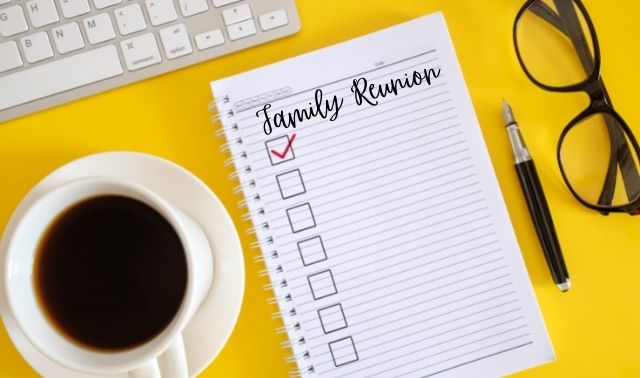Sign up for the Family Tree Newsletter Plus, you’ll receive our 10 Essential Genealogy Research Forms PDF as a special thank you!
Get Your Free Genealogy Forms
"*" indicates required fields
Written by Mary Snyder, unless otherwise noted
Jump to:
1. Send out a questionnaire for planning input.
2. Recruit and delegate tasks.
3. Create a planning command center.
4. Build a budget.
5. Prepare a back-up plan.
6. Communicate with attendees.
7. Offer activities for everyone.
8. Start the reunion with an icebreaker activity.
9. Share your family’s story.
10. Maintain the reunion’s momentum.
Related Reads
Whether you’re expecting a dozen cousins or several hundred relatives, planning a meaningful, memorable and fun family reunion is a challenge. It takes time, organizational skills and a sense of humor. These 10 steps will help make your reunion a success—and keep you sane.
1. Send out a questionnaire for planning input.
Start by picking a date and location. Professional planner Bill Gunkel of Reunions Unlimited recommends you begin planning at least 12 months ahead. Your best first step, he says, is sending questionnaires to family members to get input on when, where and what they want.
Gather a committee to select three possible dates and locations. Send questionnaires asking family members to rank the options. While you can’t meet everyone’s needs, a survey is the best tool for finding out what works for most relatives.
Are you in a reunion rut? If it’s at the same time in the same place every year, consider a change. Something as simple as a new menu (from a potluck, for example, to a catered meal) and different activities could bring the life back to the party. Whatever you decide, work within your budget and give relatives plenty of notice about the change.
Lisa A. Alzo
2. Recruit and delegate tasks.
No one person can manage all aspects of a family reunion. Surround yourself with capable and enthusiastic committee members. As the chairperson, you’ll oversee the event, handle communications between committees, coordinate the volunteers—and occasionally play peacemaker.
For small events with 20 or 30 people, you’ll need only a few volunteers. Large events require more volunteers and committees.
Enlist as many family members as possible, aiming for a representative from each family unit. Delegate tasks and follow up to make sure people do what they promise. Don’t worry if your committee members are scattered around the globe. You can conference call via Skype or start a Google Hangout. Skype text and voice chats with multiple people are free, but you’ll need a premium account to initiate a multiperson video chat. Google Hangouts are free for up to 10 people. You also can share files and spreadsheets on Google Drive or Dropbox.
This strategy has worked well for my family. Email and conference calls with members representing each family works best for deciding themes, or any new or different menu items, or games, This helps us divide up the tasks among several members.
Lisa A. Alzo
Reunion Jobs
- Finance director: handles the reunion checking account, maintains the budget, makes purchases
- Lodging liaison: finds accommodations and negotiates group discounts
- Food director: works with the caterer or handles the potluck
- Correspondence officer: communicates with family members
- Entertainment director: organizes activities for a variety of ages
- Reservations officer: tracks who’s coming
- Mementos procurement: gathers family mementos for display
- Welcome committee: makes name tags, agendas and signage; mans registration; helps people mingle
- Keepsakes collector: makes or purchases keepsake favors ahead of time, and passes them out at the gathering
3. Create a planning command center.
A reunion generates paperwork: Even with subcommittees, the reunion chairperson needs copies of pertinent information, such as contracts with food vendors, updated registration information, and lodging details.
You might keep everything in a simple file folder, or you may want separate folders for each committee in a file box. Keep your records organized—you’ll refer to them often
4. Build a budget.
The reality is your reunion will cost money. And unless you’ve hit the Powerball jackpot or have a wealthy and generous relative, you’ll need a budget and you’ll have to ask your family to pitch in. “It’s not written in stone that it must cost a lot of money. But you will need money if you’re doing mailings; and for deposits if you’re planning a banquet or reserving a park pavilion,” family reunion expert Edith Wagner says in her free How to Ask for Money podcast. “If you’re like many reunion organizers, you will be fronting some, if not all, of the money to begin. Others need to know that you expect them to contribute to and/or pay their fair share.”
You could write a letter to each family describing the upcoming reunion and asking for a contribution. Let them know how the money will be used. For more-expensive get-togethers such as cruises, offer monthly payment options. Another idea is to ask individuals to donate a service such as printing as their contribution. At the reunion, you might auction donated items to raise money for next year’s event. Keeping costs low, perhaps by booking a park shelter or community center and holding potluck meals, will encourage attendance.
In a subsequent family reunion update, asking each family to pitch in a set amount of seed money is a good way to offset startup costs. Get more dough with fundraising projects, and include financial updates in mailings.
5. Prepare a back-up plan.
If your reunion will be outside, reserve a pavilion that can accommodate all the attendees in case of unexpected weather. Pack a few board games or crafts the children can do indoors.
6. Communicate with attendees.
Send invitations as early as possible. If you wish to mail them you might opt for a simple flyer, a card or postcard, or an elaborate family newsletter. An eco-friendly option is an invite delivered via email from Evite or Punchbowl.
Meanwhile, go online to relay information and incite interest. You can create a private event page on Facebook and invite people to join, or put someone in charge of sending simple email updates from time to time. Another idea is to use a family-centered website such as Geni as a message hub.
Include family trivia in your communications! Encourage relatives to send stories, ideas and updates for the mailings. This involvement often leads to better attendance.
Share the family reunion theme
Themes are an effective way to generate enthusiasm for your reunion and coordinate food, attire, decorations and activities. Our family did an All-American theme in 2003, with red, white and blue attire; picnic classics (hamburgers, hot dogs, potato salad); and musical chairs set to patriotic tunes. Other easy themes include back to school, Christmas in July, country and western, New Year’s Eve, pajama party and toga party. Decade-based themes—’50s, ’60s, ’70s, ’80s—also work well, as do those associated with an anniversary (the 25th annual reunion; your grandparents’ 50th wedding anniversary). Themes with a heritage flair, such as Hawaiian, Irish or Mexican, can help you incorporate your family’s heritage, as would a theme celebrating your Civil War ancestor or Grandpa’s WWII service.
Announce the theme well in advance so everyone can design their costumes and your committee can coordinate food, decorations and activities. Try to stick with themes that aren’t too elaborate so family members can use what they have around the house or buy cheaply at party stores or the local dollar store.
7. Offer activities for everyone.
Structured activities are great — even necessary — for getting relatives reacquainted when they’ve been out of touch for years. Roots reunion activities have another objective: to foster the exchange of family history information. Plan pastimes that appeal to a range of ages, and encourage different generations to interact. But don’t cram the schedule: Pick a few amusements, and leave downtime between them.
For each activity, find a way to record the memories that surface. Recruit responsible volunteers to take notes, hold a video camera or use a tape recorder. The end product will be a piece of family history, a source of research leads and perhaps a reunion souvenir. We recommend the following activities:
- Show-and-tell session: Ask everyone to bring an heirloom, photo or other memorabilia and share a story about it.
- Oral history interviews: They can be as simple as pairing up people with questionnaires, clipboards and pens. Or for a more “official” result, appoint a few relatives to conduct lengthier sessions.
- Family recipe bake-off: Publish recipes and a bake-off announcement in your reunion newsletter. Let Grandma judge whose apple pie tastes most like her own.
- Story time: Ask older relatives to tell family stories. Prepare prompts, such as “What about the time Grandpa had his tonsils out?” to encourage them if needed.
- Family trivia: Gather entertaining facts about ancestors, and hold a Trivial Pursuit-or spelling bee-style quiz. Or you can turn the game into an icebreaker: Give each person a printed list of questions to answer (within a 5- or 10-minute period) by asking other relatives. Small framed photos make good prizes.
- Field trip: Many cities have history-focused tour companies that can lead your expedition; these businesses may even arrange private outings for large groups. If your family’s more adventurous (or independent), print maps for self-guided tours. The d’Alvigny family, who descend from Confederate surgeon Noel d’Alvigny, toured the Civil War cyclorama painting in Atlanta’s Grant Park, as well as the cemetery where Dr. d’Alvigny is buried.
- Genealogy workshop or round table: Hold a get-started class, ask family historians to bring their research and compare notes, or treat the group with a research trip to the library or courthouse.
- Nostalgic games: Set up marbles, checkers, hopscotch, horseshoes, baseball or other games your ancestors played.
- Candid camera: Place disposable cameras on tables throughout the room. Kids love them, and you’re guaranteed to have plenty of reunion photos.
Don’t depend on these activities to get answers to specific genealogical questions, though — in the hustle and bustle, relatives might get distracted and forget details. Instead, schedule off-site time to interview Great-aunt Ethel or convene with family historians.
Diane Haddad
For kids, aim for a mix of outdoor and indoor activities. Teenagers can organize the younger children’s games.
8. Start the reunion with an icebreaker activity.
Linda Johnson Hoffman, author of The Reunion Planner (Goodman Lauren Publishing), suggests icebreakers to kick off the reunion. “Getting everyone involved as they arrive is essential to setting the right tone,” she says.
Icebreaker Activities
- Have a welcoming committee greet arriving guests.
- Create a blank family tree and have each member fill in his information.
- Provide an agenda of activities so no one gets left out.
- Create welcome banners
- Give away freebies, such as imprinted pens or notepads, at registration
9. Share your family’s story.
Once you’ve decided the planning particulars, you’re ready to move on to the genealogy particulars. That includes instilling enthusiasm among the invitees. Start a newsletter or Web site to report reunion updates and communicate your roots focus. Make it fun by publishing old “mystery” photos or family trivia. Promise to reveal the answers at the reunion, or offer prizes for the first correct answer. Consider including a family history questionnaire to collect stories. For help crafting one, visit .
Also ask family members to send copies of photos, letters and other memorabilia for a reunion display. “The Busse Family Reunion, cited in the Guinness Book of World Records as the country’s largest reunion, had a whole exhibition hall at the Lake County [Ill.] Fairgrounds to display family history and artifacts, including a collection of wedding dresses,” Wagner says. But there’s no need to rent a hall — even a dozen objects and photos arranged on a corner table will inspire memories and discussions about who has Great-grandpa Ed’s chin.
Use copies of original documents when possible, and keep your display in an out-of-the-way spot — otherwise you’ll be known as the mean relative who shot dirty looks at anyone approaching the photo table with a soda. Frame photos or put them in plastic page protectors with names and dates on label stickers. If you don’t know who’s pictured, write that on the label. Provide pens and paper in case a cousin can supply details. Other ideas for setting the roots mood:
- Highlight an ancestor’s experience — such as immigrating to America or following the California Gold Rush — with a history display: Search the internet for photos and information, visit museums for brochures and create a fact sheet about your ancestor’s experience.
- Post a giant family tree chart: Print one from your genealogy software, or draw your pedigree on taped-together sheets of paper (or butcher paper). Melanie Fagan of Crestwood, Ill., color-codes her tree’s branches with name tags to show at a glance where everyone fits. “The tree is tacked to a long table or wall, with a pen for people to make additions,” Fagan says. “Even people who don’t have anything to add love to look at it.”
- Serve heritage-based foods and family favorites for dinner: Work with the caterers to use some of your recipes, or you can hold a potluck and assign relatives to bring their famous dishes.
Diane Haddad
More family history ideas
You’ll certainly want to bring along a printed copy of the family tree to explain connections, but a mile-long chart might not be the best way to capture the attention of your attendees. You’ll likely generate more interest with displays of photos, albums and heirlooms. If fact, a photo guessing game makes a fun activity. At one of our family reunions with a Pajama Party theme, for example, we had a Name that Napper contest: We plastered a poster board with pictures of family members napping at reunions over the years, and attendees had to guess who was in each photograph. The person with the most answers received a prize, and the game became a conversation starter.
Another great project is to convert your old home movies and videotapes of past gatherings to DVD or digital files (you were planning to do that anyway, right?), or use an online service to play at the reunion. Pair up relatives for oral history interviews with questions you’ve provided. Have them record the interviews with a smartphone or tablet app such as Evernote. Or you could have them record their memories by phone and create a LifeOnRecord.
Lisa A. Alzo
10. Maintain the reunion’s memories and momentum.
After the reunion, plan to keep in touch until the next one. Family newsletters and websites are great for this. Recruit volunteers to send a newsletter, create and monitor a page on Geni or Facebook, or build a beautiful family history website!
Let attendees take home souvenirs that enhance family unity and share the memories you’ve gathered. Someone (perhaps a designated “keepsakes collector”) can make or purchase mementos ahead of time, and then pass them out at the gathering. Or everyone can contribute to a project during the reunion, and you can mail copies of the finished product afterward. To ease distribution, have anyone who wants a copy self-address an appropriate-sized envelope and put postage money inside. Use one of these suggestions:
- Pedigree charts and family directories: They’re easy to put together, and you can spice them up with the report options in your genealogy software. Use the reunion newsletter to let relatives update contact information or opt out of being listed.
- Family history book: Mary Briggs of Tigard, Ore., sent an information-gathering letter before her family rendezvous: “I explained that I was going to put together a genealogy book that would be available at the reunion. I also asked for copies of documents, newspaper clippings, stories or old pictures.” Briggs assembled these contributions with her research materials — a total of 500 pages — and had them copied and put in three-ring binders. She sold the books at cost, about $40.
- Video- or audiotape of reunion footage: Aside from allowing your cousins to relive the reunion fun, this option lets everyone have a “real-time” record of the family history discoveries made during the reunion — it’s ideal for preserving and sharing interviews or storytelling sessions.
- Reunion portrait: Don’t pass up the opportunity to shoot a group photo while you’re all in one place.
- Family recipe book: Along with recipes (solicited in the newsletter), include photos of family bakers and stories about their goodies.
- “Brag book”-sized photo album of family photos: Incorporate pics from those disposable cameras you placed around the room, as well as copies of ancestral photos shared during the festivities. You also might include a photo (or miniature copy) of the family tree chart you displayed.
- Scrapbook: Have each family create a page using provided papers, pens and Polaroids (or employ that handy newsletter to ask people to bring photos). Later, scan or color-copy the pages and mail them out.
Diane Haddad
Use a family email newsletter to share reunion updates, family stories, photos and recipes year-round. Collaborate on family tree research, participate in a fantasy football league, set up an NCAA basketball bracket, or check out other interactive online games. To guide your planning for next year, distribute a survey at the end of the event on paper, or via email a few days after.
Lisa A. Alzo
Versions of this article appeared in the April 2001 (Snyder), June 2004 (Haddad), and September 2013 (Alzo) issues of Family Tree Magazine.
Share this slideshow with your genealogy group!
Related Reads
ADVERTISEMENT







